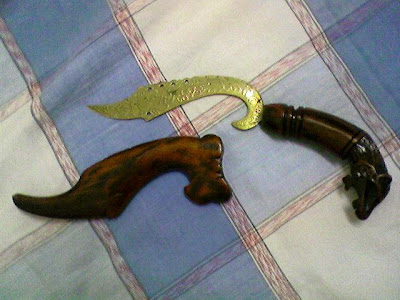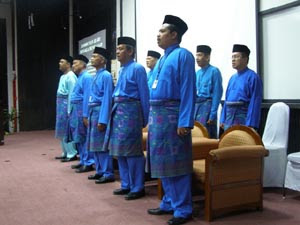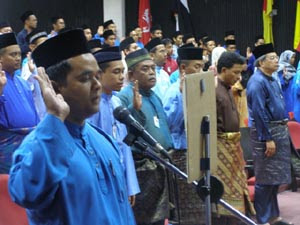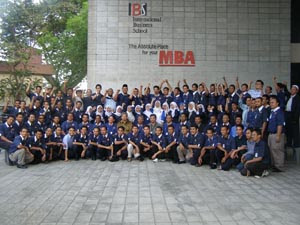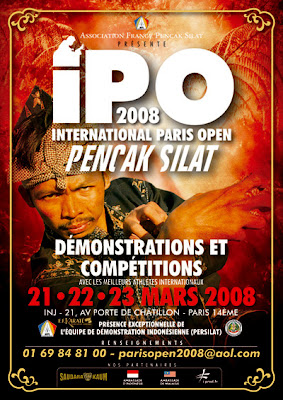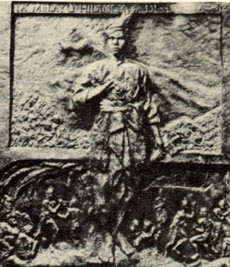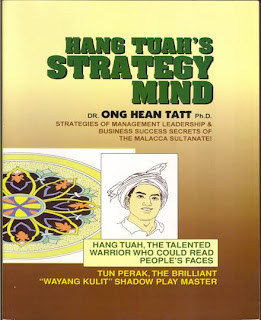The following are guidelines for Silat in Malaysia as stipulated by the JAKIM, the Department of Islamic Development Malaysia. I intend to translate them when I have the time, but for now, I'll put up the Bahasa Melayu version. When the translation is complete, I'll repost it to a later date. I invite discussion and/or debate from readers on the guidelines presented.
1. PURPOSE1.1 These guidelines are prepared to ensure that Muslims, especially those involved in traditional self-defence arts (silat) are tno involved in any practices that deviate from the true aqidah and shariah of Islam.
2. INTRODUCTION2.1. Islam amat menitikberatkan soal-soal akidah dan syariah. Segala amalan dan kepercayaan yang tidak berdasarkan kepada sumber-sumber asal Al-Quran, Hadis, Ijmak dan Qias adalah ditolak. Kepercayaan-kepercayaan dan amalan-amalan tertentu dalam masyarakat Islam di Malaysia sedikit sebanyak ada hubungkaitnya dengan pengaruh fahaman Anamisme, Dinamisme, Hindu, Buddha dan Syiah (Ghulu) yang sebahagiannya telah menjadi darah daging kepada pengamal suci mempertahankan diri tradisional (silat).
Oleh itu garis panduan ini perlu dijadikan asas dan panduan supaya dapat mengelakkan diri dari terjerumus ke dalam penyelewengan akidah dan syariat Islam. Allah berfirman dalam surah Yunus, ayat 106:
ولا تدع من دون الله ما لا ينفعك ولا يضرك فان فعلت فانك اذا من الظالمين
(سورة يونس : 106)
Bermaksud:
“Dan janganlah kamu menyembah apa-apa yang tidak memberi manfaat dan tidak (pula) memberi mudharat kepadamu selain Allah; sebab jika kamu berbuat (yang demikian) itu, maka sesungguhnya kamu termasuk orang-orang yang zalim”.
2.2. Dalam sejarah Islam memang wujud pahlawan-pahlawan yang tekemuka di kalangan para sahabat Rasulullah s.a.w. Mereka telah berjuang menentang Musyrikin Quraisy dan penentang-penentang ajaran Islam dari kalangan Munafikin. Antara sahabat berkenaan ialah Saidina Ali, Khalid Ibnu Walid, Amru b. As-As, Abu Ubaidah b. Al-Jarrah, Saad b. Abi Waqas dan lain-lain lagi.
Di dalam Al-Quran didapati banyak ayat-ayat yang menunjukkan bahawa perlunya umat Islam mempersiapkan diri dan kelengkapan senjata serta kemudahan-kemudahan yang perlu untuk mempertahankan agama, diri dan negara. Antaranya ayat 61 surah Al-Anfaal:
وان جنحوا للسلم فاجنح لها وتوكل على الله انه هو السميع العليم
(الانفال : 61)
Bermaksud:
“Dan jika mereka (pihak musuh) cenderung kepada perdamaian, maka engkau juga hendaklah cenderung kepadanya serta bertawakkallah kepada Allah. Sesungguhnya Ia Maha Mendengar, lagi Maha Mengetahui”.
2.3. Di dalam ilmu persilatan terdapat beberapa syarat yang perlu dipatuhi sama ada ketika hendak masuk silat, setelah masuk atau selepas tamat dan diijazahkan. Di antara syarat-syarat tersebut:
(a) menyediakan pengeras seperti pulut kuning, limau purut, kain putih, bayaran pengeras dan sebagainya.
(b) mandi dengan air mandian tertentu sebagai lambang membersihkan segala kekotoran zahir dan batin.
(c) tidak boleh meninggalkan sembahyang.
(d) Tidak boleh banyak bertanya ketika guru sedang mengajar atau mempersoalkan sebarang tindakan guru.
(e) Melakukan gerak silat membuka atau menutup gelanggang setiap kali memula atau menamatkan latihan silat.
2.4. Guru memainkan peranan penting di dalam menyampaikan sesuatu ilmu bagi menjamin kesahihan dan kesempurnaan ilmu tersebut. Di dalam ilmu persilatan, guru adalah lambang kesempurnaan.
2.5. Sesuatu seni mempertahankan diri tradisional (silat) itu perlulah didasarkan kepada garis pandua berikut bagi mengenalpasti ianya terhindar dari perkara-perkara yang bercanggah dengan syariat Islam:
(a) Asal Usul Silat
(b) Syarat-Syarat Silat
(c) Guru Silat
(d) Ikrar Sumpah dan Taat Setia
(e) Pantang Larang
(f) Adab
(g) Gerak Langkah
(h) Amalan Dalam Silat
(i) Pengijazahkan
(j) Matlamat Silat
3. GUIDELINES FOR SILAT AND SELF DEFENCE ARTS
3.1. Origins of Silat
3.1.1. Demi menjaga kesucian akidah Islam, beberapa perkara perlu diambil perhatian iaitu setiap individu atau kumpulan tidak boleh mendakwa bahawa:
(a) Silat mereka bersumber dari Nabi Muhammad s.a.w. para anbia atau diambil dari Al-Quran dan Hadis atau berasal dari amalan para sahabat Nabi s.a.w.
(b) Teknik atau pergerakan persilatannya berasal dari ibadat-ibadat tertentu seperti rukun-rukun sembahyang.
(c) Seni silat mereka bersumberkan mimpi bertemu Rasulullah s.a.w. atau para anbia yang lain atau para sahabat serta ulama.
3.2. Conditions of Silat3.2.1. Bagi mempastikan syarat-syarat di dalam ilmu persilatan tidak bercanggah dengan ajaran Islam maka:
(a) Semua perkara yang wajib dilakukan atau ditinggalkan oleh seorang Islam, yang mukallaf tidak boleh dijadikan syarat di dalam silat seperti sembahyang, puasa, jangan durhaka kepada ibubapa, sehingga mendatangkan anggapan bahawa perkara wajib tersebut menjadi wajib hanya apabila dijadikan syarat.
(b) Tidak boleh mengaitkan sesuatu pengeras dengan suatu akibat yang dipercayai boleh merosakkan pegangan akidah.
(c) Tidak boleh percaya kepada sial seperti mandi membuang sial atau mandi-mandi tertentu yang dikaitkan dengan persilatan.
(d) Tidak boleh melakukan gerak silat atau bacaan tertentu yang mengandungi unsur-unsur meminta izin atau bantuan dari kuasa-kuasa makhluk “ghaib” dalam acara “gerak membuka atau menutup gelanggang”, “’ayat kebal” atau “pukulan angin maut” atau sembelih ayam dalam gelanggang.
(e) Tidak boleh mentaati guru atau seseorang pada perkara-perkara yang jelas bercanggah dengan akidah dan syariat Islam.
(f) Sebarang syarat yang bertentangan dengan akidah, syariah dan akhlak Islam.
3.3. Silat Masters
3.3.1. Guru silat yang beragama Islam hendaklah bukan terdiri daripada:
(a) mereka yang melakukan perkara-perkara syirik, sama ada melalui perkataan, perbuatan atau iktikad.
(b) mereka yang melakukan maksiat/jenayah dan yang bertentangan dengan moral.
(c) pemecah belah masyarakat.
(d) Mereka yang mentafsir ajaran agama Islam mengikut hawa nafsu.
3.3.2. Jika seseorang guru silat hendak melibatkan diri dalam hal agama hendaklah mengetahui asas-asas agama Islam sama ada fardhu ain atau fardhu kifayah seperti rukun Islam, rukun Iman, cara mengerjakan sembahyang dan sebagainya.
3.3.3. Guru silat dilarang memasukkan atau menggunakan unsur-unsur yang bercanggah dengan Islam seperti sihir dan ilmu kebal di dalam ilmu persilatan.
3.4. Oaths and Promises of Loyalty
3.4.1. Sumpah tidak dibolehkan sebaliknya hanya ikrar.
3.4.2. Murid-murid tidak boleh taat secara membuat tuli kepada guru. Mereka hendaklah mengikut perintah guru selama tidak bercanggah dengan perintah Allah.
3.4.3. Sumpah tidak boleh digunakan kepada perkara-perkara yang telahpun diwajibkan di dalam Islam seperti bersumpah akan taat kepada ibubapa, bersumpah akan taat kepada Allah dan Rasul dan sebagainya.
3.4.4. Bacaan-bacaan, amalan dan ikrar yang terdapat di dalam sumpah hendaklah mengandungi perkara-perkara yang tidak bercanggah dengan akidah dan syariat Islam seperti memuja dewa, atau nama berhala.
3.4.5. Di dalam upacara sumpah dan bai’ah sama ada dari segi fizikal atau mental hendaklah tidak mempunyai unsur-unsur yang mensyirikkan Allah dan menjatuhkan maruah seseorang sebagai umat Islam.
3.5. Taboos & Restrictions
3.5.1. Suatu pantang larang hendaklah bukan daripada perkara-perkara yang jelas diwajibkan di dalam Islam seperti tidak meninggalkan sembahyang, jangan berkelahi sesama ahli dan sebagainya.
3.5.2. Suatu pantang larang tidak boleh dikaitkan dengan unsur-unsur pemujaan, meminta izin, perlindungan atau bantuan daripada makhluk-makhluk ghaib seperti larangan berludah kerana ditakuti tidak menjadi.
3.5.3. Tidak boleh memenuhi kehendak pantang larang sehingga melakukan perkara-perkara yang ditegah di dalam Islam seperti meninggalkan tanggungjawab sebagai suami atau isteri dan sebagainya.
3.5.4. Perkara-perkara yang harus dan halal tidak boleh dihukumkan haram.
3.6. Etiquette3.6.1. Etiquette between Student and Master:
(a) Guru tidak boleh menganggap dirinya yang paling mulia dan tidak pernah bersalah.
(b) Guru hendaklah mengelakkan diri dari dianggap orang yang perlu ditaati secara mutlak.
(c) Guru tidak boleh menganggap orang lain lemah dan lekeh.
(d) Guru hendaklah melarang murid-muridnya memuja, mengagung dan taksub kepadanya.
3.6.2. Etiquette between Student and Fellow Students:
(a) Seseorang murid tidak boleh memberikan hak secara khusus kepada murid seperguruannya sahaja, seperti memberi ucapan salam, tidak boleh bergaduh sesama ahli dan sebagainya.
(b) Seseorang murid tidak boleh menanam atau mengapi-apikan perasaan bangga diri dan taksub kepada kumpulannya sehingga memandang hina dan negatif kepada orang lain.
3.6.3. Etiquette between Student and Other People
(a) Seseorang murid tidak boleh mengutamakan guru silat dan murid-murid seperguruannya sehingga mengabaikan hak dan kewajipannya kepada ibubapa, suami, isteri, anak dan ahli keluarga.
(b) Seseorang murit tidak boleh memandang rendah dan hina terhadap orang bukan dari kalangan ahli silatnya.
(c) Seseorang murid yang beragama mesti menjalinkan ikatan persahabatan sama ada sesama ahli atau orang lain.
3.7. Physical Movements
(a) Gerak langkah silat tidak boleh dikaitkan dengan zat Allah dan sifat-sifat-Nya atau merupakan maksud di sebalik kalimah atau nama-nama Allah atau sifat-sifatNya.
(b) Gerak langkah silat tidak boleh diertikan sebagai maksud yang tersirat daripada ahli atau jasad Rasulullah s.a.w., para malaikat, nabi-nabi dan orang soleh.
(c) Gerak langkah silat tidak boleh dimaksudkan dengan perkara-perkara yang berkaitan dengan agama Islam atau perlakuan-perlakuan ibadat yang tertentu seperti dua kalimah syahadah dan sembahyang.
3.8. Spiritual Practices In Silat
(a) Tidak boleh memuja dan memperhambkan diri kepada sesuatu kuasa atau peribadi yang boleh mendatangkan nasib baik atau buruk kepada seseorang seperti hantu, dewa, keramat, kubur, keris, busut dan sebagainya.
(b) Tidak boleh menggunakan tangkal dan azimat yang mengandungi rajah-rajah atau tulisan-tulisan yang tidak difahami, objek-objek tertentu dan bercampuraduk dengan ayat Al-Quran.
(c) Tidak boleh mengamalkan bacaan-bacaan tertentu yang tidak difahami maknanya dikhuatiri mengandungi kata-kata pemujaan kepada berhala, iblis, syaitan atau nama berhala orang kafir serta bercampur aduk dengan ayat al-Quran.
(d) Tidak boleh meninggalkan ibadat-ibadat wajib yang dituntut di dalam Islam seperti sembahyang lima waktu dan puasa di bulan Ramadan ketika melakukan amalan silat.
3.9. Initiation/ Graduation
(a) Tidak boleh melakukan isyarat sembah atau gerak tubuh yang melambangkan ketundukan yang menyamai atau melebihi ketundukan yang hanya layak kepada Allah sahaja seperti tidak sembah kepada guru.
(b) Tidak boleh melakukan upacara-upacara yang mengandungi unsur-unsur penyembahan, pemujaan, memohon bantuan atau memperhambakan diri kepada kuasa-kuasa atau tenaga-tenaga ghaib seperti mempersembahkan sedulang makanan, menyembelih ayam dan sebagainya.
3.10. Objectives of Silat (a) Matlamat silat hendaklah matlamat yang baik seperti untuk kesihatan tubuh badan, mendisiplinkan diri, hidup bermasyarakat, untuk mempertahankan diri dari bahaya dan sebagainya.
(b) Matlamat silat tidak boleh:
(i) Untuk membalas dendam, menuntut bela, membuat aniaya, menakut-nakutkan dan mengugut orang lain.
(ii) Untuk menanam sifat berani yang keterlaluan sehingga hilang hormat kepada ibubapa, guru, ahli keluarga dan lain-lain.
(iii) Untuk memupuk sentimen perkauman atau taksub golongan/kumpulan ekstrim agama yang melampau di kalangan ahli.
4. CONCLUSIONDengan mengikut garis panduan ini diharapkan para pengamal silat dan seni mempertahankan diri supaya dapat menghindarkan diri menyimpang daripada ajaran Islam yang benar, agar hidup sentiasa dirahmati Allah S.W.T.
http://www.islam.gov.my/e-rujukan/silat.htmDepartment of Islamic Development Malaysia,
Kuala Lumpur.









